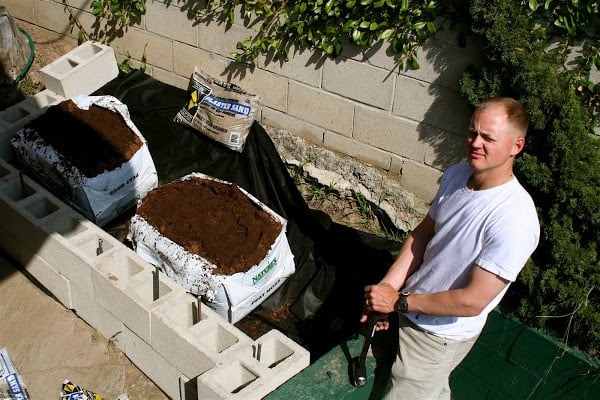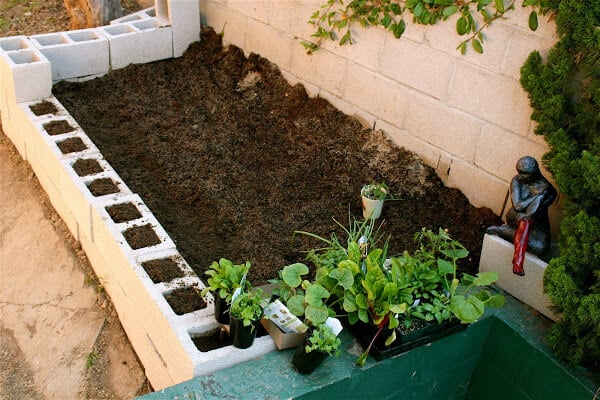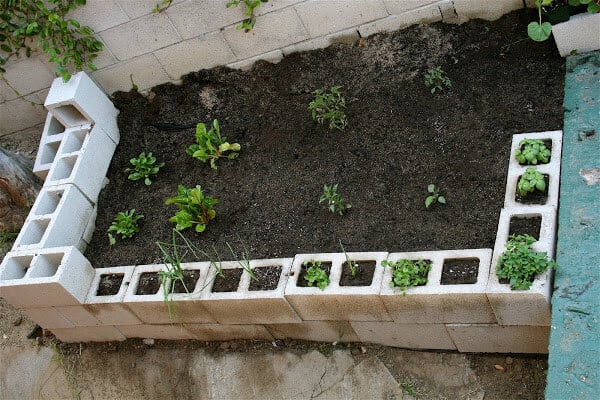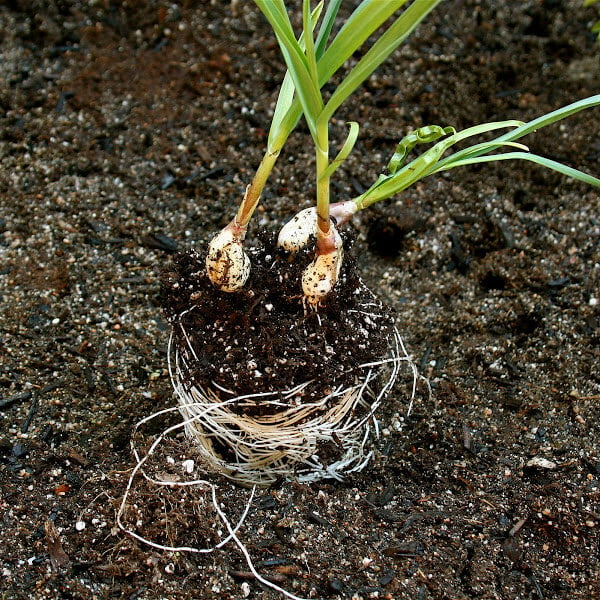Cinder-Block Garden How-To
This post may contain affiliate links. Please read my disclosure policy.

Step 1. Marry someone strong who will do all the heavy lifting in the project.
Step 2. Download Lynn Gillespie’s e-book Cinder Block Gardens for $19.95. Read the book.
Step 3. Make a list and head to Home Depot, Lowe’s or your local garden shop. A pickup truck is handy for this trip. The supplies weigh in total almost 1500 pounds.
Basic supplies include:
• 24 cinder blocks ($0.79 each)
• 2 bales 3.8 c.f. peat moss ($12.00 each)
• 10 50-lb. bags all-purpose sand ($2.80 each)
• 3 bags 2 c.f. compost ($6.00 each)
• 1 roll commercial-grade weed barrier ($11.00)
If you are a novice gardener, consider these additional items:
• garden hose
• spray nozzle
• sink adapter if you don’t have an outside water source
• shovel and rake
• rebar stakes and sledgehammer if building on a slope
Costs to consider down the road:
• mulch
• cages for plants such as tomatoes
• trellis for plants such as pole beans
Related Post: Garden Update and Garden Update II



Step 7. Consider starting a compost pile. Purchase a compost container on-line or from your home-garden center, or construct one following Ms. Gillespie’s instructions. This is the one I have my eye on. It only costs $500.


This post may contain affiliate links. Please read my disclosure policy.












8 Comments on “Cinder-Block Garden How-To”
Ali- so great! I wish a had a place to put a cinder block garden. It looks like it would be really fun to do. I love how you plant things in the nooks of the cinder blocks. Can’t wait to see how much you’re able to harvest! Keep those buggies away!
We ate two tiny ripe strawberries yesterday from our plants that we planted back in late February 🙂
Ali- I love it and can’t wait to see how this progresses! Cinder Block gardens: further reason to buy a house in the city!
I love to see that someone else had done this! We have 12 of these in our backyard that produce and incredible amount of fruits and veggies for us over the summer. We’ve also built a hoop house over 2 of them to extend our growning season. The hoop house is PVC conduit and heavy clear plastic – so simple and so effective! We’ve never planted in the holes of the Cinder Blocks. Thanks for the great idea
So cool to hear this! You need to blog about it! I now live in VA and don’t have one set up yet. I need to get on that next spring. Would love to see how your hoop house is set up too. You don’t happen to raise chickens, too, do you? That’s on my mind, too. Thanks for writing in!
Thanks so much for sharing! We are doing our very first garden this year, and I had just downloaded the ebook younare referencing when I found this page. I have sort of a dumb question… Would it work to just plant everything inside the holes? Or do many of the roots just get too big/plants need more room to stretch out? I was hoping to maximize space by doing a tiered set-up, using the holes as individual planters. But most folks don’t seem to do this. I’m sure there’s a simple reason why, but since we have limited space and are keeping things small (only tomatoes, peppers, lettuce, and a couple of bean plants) I was hoping it might work. Any feedback welcome. Thanks again for taking the time to spell all this out for us.
Hi Jen,
So, I think you can plant lots of things in the cinderblock holes — for instance, herbs, but also things like pole beans and snap peas. We had great success planting snap peas in about six of the holes one year. (One snap pea plant per hole.) I think some of the other planting options, however, will be too big for the holes. For instance, and the book says this, but I think the whole space can only handle four tomato plants. We crowded a few more in one year, and it worked fine, but I think the tomato plants would have been too big for the holes.
So, as far as what you are planning on planting, I think you could do peppers and bean plants in the holes but not the tomatoes. And I’m not sure about the lettuce, but I think you might be able to plant one or two heads per hole. I wish I could be more helpful. We moved from CA to VA last April, and I didn’t plant a garden last summer. So disappointing. I’m doing herbs this year all in pots on my deck. The lady at the nursery said I could do lettuce in the pots as well, so I imagine you would be able to do lettuce in the holes, but I don’t want to lead you astray.
Hope this helps. Let me know if I can answer any more questions. Good luck with your gardening!
Thanks so much, that does help! This changes my plan a little bit, but that is OK. I am excited to get started. Really bummed for you that you had to leave your awesome garden behind. Hope you are able to do something similar at some point. Thanks again!
Jen, I know, it really was sad leaving the garden behind. Never did I imagine getting attached to cinderblocks, but alas, I did. Good luck with the garden! Report back if you make any discoveries!